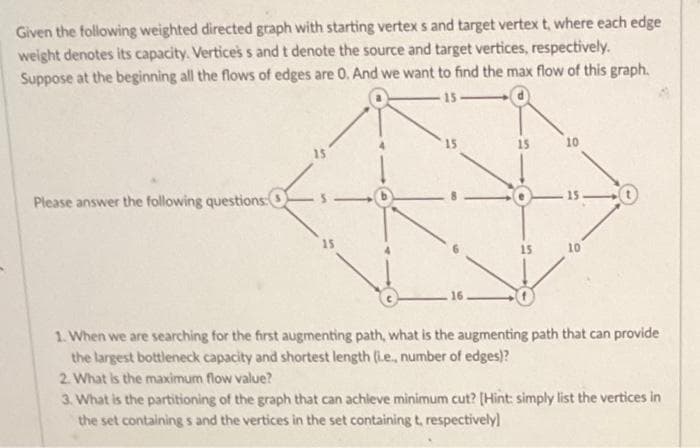Given the following weighted directed graph with štarting weight denotes its capacity. Vertices s and t denote the source and target vertices, respectively. Suppose at the beginning all the flows of edges are 0. And we want to find the max flow of this graph. 15 15 10 15 – 15 0 Please answer the following questions: 15 10 16. 1. When we are searching for the first augmenting path, what is the augmenting path that can provide the largest bottleneck capacity and shortest length (Le, number of edges)? 2. What is the maximum flow value? 3. What is the partitioning of the graph that can achileve minimum cut? [Hint: simply list the vertices in the set containings and the vertices in the set containing t, respectively]
Given the following weighted directed graph with štarting weight denotes its capacity. Vertices s and t denote the source and target vertices, respectively. Suppose at the beginning all the flows of edges are 0. And we want to find the max flow of this graph. 15 15 10 15 – 15 0 Please answer the following questions: 15 10 16. 1. When we are searching for the first augmenting path, what is the augmenting path that can provide the largest bottleneck capacity and shortest length (Le, number of edges)? 2. What is the maximum flow value? 3. What is the partitioning of the graph that can achileve minimum cut? [Hint: simply list the vertices in the set containings and the vertices in the set containing t, respectively]
Computer Networking: A Top-Down Approach (7th Edition)
7th Edition
ISBN:9780133594140
Author:James Kurose, Keith Ross
Publisher:James Kurose, Keith Ross
Chapter1: Computer Networks And The Internet
Section: Chapter Questions
Problem R1RQ: What is the difference between a host and an end system? List several different types of end...
Related questions
Question

Transcribed Image Text:Given the following weighted directed graph with starting vertex s and target vertex t, where each edge
weight denotes its capacity. Verticess and t denote the source and target vertices, respectively.
Suppose at the beginning all the flows of edges are 0. And we want to find the max flow of this graph.
15
15
10
15
Please answer the following questions:
- 15 0
15
15
10
16
1. When we are searching for the first augmenting path, what is the augmenting path that can provide
the largest bottleneck capacity and shortest length (Le., number of edges)?
2. What is the maximum flow value?
3. What is the partitioning of the graph that can achieve minimum cut? [Hint: simply list the vertices in
the set containing s and the vertices in the set containing t, respectively)
Expert Solution
This question has been solved!
Explore an expertly crafted, step-by-step solution for a thorough understanding of key concepts.
Step by step
Solved in 2 steps with 2 images

Recommended textbooks for you

Computer Networking: A Top-Down Approach (7th Edi…
Computer Engineering
ISBN:
9780133594140
Author:
James Kurose, Keith Ross
Publisher:
PEARSON

Computer Organization and Design MIPS Edition, Fi…
Computer Engineering
ISBN:
9780124077263
Author:
David A. Patterson, John L. Hennessy
Publisher:
Elsevier Science

Network+ Guide to Networks (MindTap Course List)
Computer Engineering
ISBN:
9781337569330
Author:
Jill West, Tamara Dean, Jean Andrews
Publisher:
Cengage Learning

Computer Networking: A Top-Down Approach (7th Edi…
Computer Engineering
ISBN:
9780133594140
Author:
James Kurose, Keith Ross
Publisher:
PEARSON

Computer Organization and Design MIPS Edition, Fi…
Computer Engineering
ISBN:
9780124077263
Author:
David A. Patterson, John L. Hennessy
Publisher:
Elsevier Science

Network+ Guide to Networks (MindTap Course List)
Computer Engineering
ISBN:
9781337569330
Author:
Jill West, Tamara Dean, Jean Andrews
Publisher:
Cengage Learning

Concepts of Database Management
Computer Engineering
ISBN:
9781337093422
Author:
Joy L. Starks, Philip J. Pratt, Mary Z. Last
Publisher:
Cengage Learning

Prelude to Programming
Computer Engineering
ISBN:
9780133750423
Author:
VENIT, Stewart
Publisher:
Pearson Education

Sc Business Data Communications and Networking, T…
Computer Engineering
ISBN:
9781119368830
Author:
FITZGERALD
Publisher:
WILEY